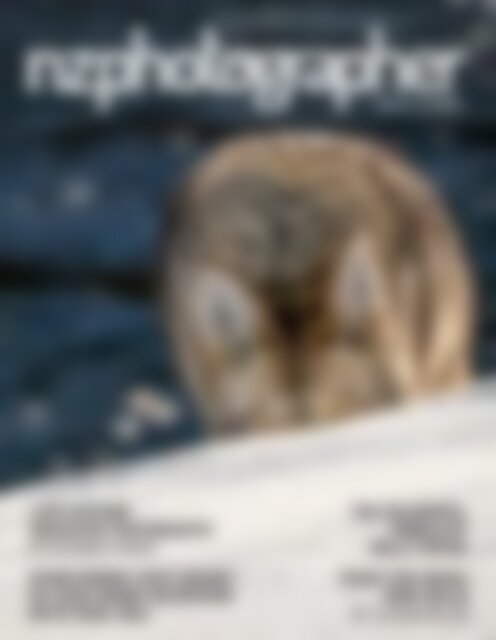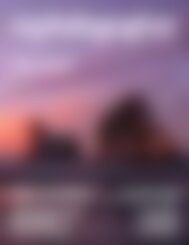NZPhotographer Issue 33, July 2020
As of December 2022, NZPhotographer magazine is only available when you purchase an annual or monthly subscription via the NZP website. Find out more: www.nzphotographer.nz
As of December 2022, NZPhotographer magazine is only available when you purchase an annual or monthly subscription via the NZP website. Find out more: www.nzphotographer.nz
You also want an ePaper? Increase the reach of your titles
YUMPU automatically turns print PDFs into web optimized ePapers that Google loves.
ISSUE <strong>33</strong>, <strong>July</strong> <strong>2020</strong><br />
LATE AUTUMN<br />
SEASCAPE PHOTOGRAPHY<br />
BY RICHARD YOUNG<br />
OVERCOMING SELF-DOUBT<br />
IN YOUR WORK INTERVIEW<br />
WITH PAUL REA<br />
THE COLOURFUL<br />
WORLD OF<br />
KELLY VIVIAN<br />
FROM THE ROAD:<br />
NEW DELHI<br />
BY <strong>July</strong> SUSAN <strong>2020</strong> BLICK1
WELCOME TO ISSUE <strong>33</strong> OF<br />
NZ PHOTOGRAPHER MAGAZINE<br />
HELLO EVERYONE,<br />
This month's magazine is full of<br />
travel adventures to inspire you to<br />
get out there with your camera<br />
whether you're more than happy<br />
to stay on home turf for the time<br />
being, or are eagerly anticipating<br />
the re-opening of all borders<br />
around the world post lockdown.<br />
Susan Blick is here to take us on<br />
the road to New Delhi, we travel<br />
to Lake Emma with Brendon<br />
Gilchrist, and hear how Garett<br />
Vincent went off on an adventure<br />
chasing the Endeavour last<br />
November in Behind The Shot. We also enter into the colourful<br />
world of Kelly Vivian to learn how she went from sports<br />
photography to fine art photography and travel the world<br />
with Paul Rea whilst discussing self-doubt in your work and<br />
ways to overcome that.<br />
We're also thinking seasonal photography for those on you<br />
in the Southern hemisphere with Richard Young offering<br />
inspiration for late Autumn photography, and Readers'<br />
Submissions showcasing some of your best Winter shots from<br />
around the world.<br />
Emily Goodwin<br />
Editor NZ Photographer<br />
<strong>NZPhotographer</strong> <strong>Issue</strong> <strong>33</strong><br />
June <strong>2020</strong><br />
Cover Photo<br />
Snow Blind by<br />
Lynne Roberts<br />
Publisher:<br />
Foto Lifestyle Ltd<br />
Website:<br />
nzphotographer.nz<br />
Graphic Design:<br />
Maksim Topyrkin<br />
Advertising Enquiries:<br />
Email<br />
hello@nzphotographer.nz<br />
FOLLOW US<br />
OUR CONTRIBUTORS<br />
Brendon Gilchrist<br />
Brendon is the man behind<br />
ESB Photography. He is an<br />
avid tramper who treks<br />
from sea to mountain, and<br />
back again, capturing the<br />
uniqueness of New Zealand’s<br />
unforgiving landscape.<br />
Richard Young<br />
Richard is an award-winning<br />
landscape and wildlife<br />
photographer who teaches<br />
photography workshops and<br />
runs photography tours. He is<br />
the founder of New Zealand<br />
Photography Workshops.<br />
© <strong>2020</strong> <strong>NZPhotographer</strong> Magazine<br />
All rights reserved. Reproduction of any material appearing in this magazine in any form is forbidden without prior<br />
consent of the publisher.<br />
Disclaimer:<br />
Opinions of contributing authors do not necessarily reflect the opinion of the magazine.<br />
2<br />
<strong>NZPhotographer</strong>
CONTENTS<br />
4<br />
6<br />
10<br />
16<br />
22<br />
30<br />
31<br />
38<br />
56<br />
BEHIND THE SHOT<br />
with Garett Vincent<br />
LAKE EMMA<br />
by Brendon Gilchrist<br />
FROM THE ROAD: NEW DELHI<br />
by Susan Blick<br />
THE COLOURFUL WORLD<br />
OF KELLY VIVIAN<br />
INTERVIEW WITH PAUL REA<br />
INSIGHTS FROM<br />
@EXCIO PHOTO COMMUNITY<br />
EXCIO TOP 10<br />
MINI 4 SHOT PORTFOLIO<br />
LATE AUTUMN SEASCAPE PHOTOGRAPHY<br />
by Richard Young<br />
62 PORTFOLIO<br />
BEST READERS' SUBMISSIONS THIS MONTH<br />
MEMBERSHIP<br />
LAKE EMMA<br />
BY BRENDON GILCHRIST<br />
THE COLOURFUL WORLD<br />
OF KELLY VIVIAN<br />
INTERVIEW WITH<br />
PAUL REA<br />
6<br />
16<br />
22<br />
FREE 12$ MONTH 120$ YEAR<br />
• Online issue<br />
• High res PDF download<br />
• Access to all back issues<br />
• Competition entry<br />
($15 per entry)<br />
• Readers gallery ($5 per entry)<br />
• 4x4 gallery submission<br />
• A chance to be featured<br />
in interviews, cover photo,<br />
behind the shot and articles<br />
• Online issue<br />
• High res PDF download<br />
• Access to all back issues<br />
• Competition entry<br />
(1st entry free)<br />
• Readers gallery (1 free entry<br />
per month)<br />
• 4x4 gallery submission<br />
• A chance to be featured<br />
in interviews, cover photo,<br />
behind the shot and articles<br />
• Online issue<br />
• High res PDF download<br />
• Access to all back issues<br />
• Competition entry<br />
(1st entry free)<br />
• Readers gallery (1 free entry<br />
per month)<br />
• 4x4 gallery submission<br />
• A chance to be featured<br />
in interviews, cover photo,<br />
behind the shot and articles<br />
SUBSCRIBE
Behind The Shot<br />
with Garett Vincent<br />
GARETT, TELL US ABOUT YOU AND YOUR<br />
JOURNEY WITH PHOTOGRAPHY…<br />
My journey with photography started in late 2016<br />
when I decided to venture out with my cell phone<br />
and explore the local area around Whangarei,<br />
Northland. During my wander, I felt a sense of<br />
connection with nature and the surrounding<br />
environment. Even though I was only using my cell<br />
phone, getting home and viewing the results gave me<br />
the inspiration to capture more as I imagined it would<br />
be a great chance to explore and capture aspects of<br />
the beautiful world we live in, especially being in New<br />
Zealand. I purchased a cheap bridge camera soon<br />
after that, then upgraded to a Nikon DSLR in 2017 and<br />
I have never looked back.<br />
TELL US ABOUT THIS IMAGE…<br />
It was late November 2019 when I heard that the<br />
Endeavour was sailing to N.Z as part of the Tuia 250<br />
year celebrations, a celebration of Captain James<br />
Cook discovering New Zealand. A replica of the 17th<br />
century ship was to navigate N.Z on the exact same<br />
path that was sailed in 1769.<br />
I’d seen this majestic ship on the back of the 50<br />
cent piece all my life and have an interest in<br />
history, especially Aoteroa’s history, so I went down<br />
to the port as the ship docked in Whangaerie to<br />
photograph it. There were children with icecreams,<br />
people with hard hats and hi vis vests, and a lot of<br />
vehicles surrounding the ship so I felt that the photos<br />
I’d taken lacked authenticity. I was determined to<br />
capture how it would have looked back in 1769 so<br />
I downloaded a ship tracker on my phone and a<br />
few days later I noticed it was on the move up the<br />
East coast towards the Bay of Islands so I packed up<br />
my photography gear and, racing the fading light<br />
as it was late afternoon, headed off in pursuit of the<br />
Endeavour.<br />
After a few stops and starts from the Endeavour at<br />
various bays along the coast which I picked up via<br />
the ship tracker, I wondered if I’d ever get to see the<br />
seemingly elusive ship as the light was fading fast and<br />
the petrol gauge on my car was running low. Driving<br />
43km on the most winding and nauseating gravel<br />
roads I’d ever driven on in what seemed like the<br />
middle of nowhere my hope was fading as fast as the<br />
light but I finally came to a dead end of the council<br />
road at a settlement called Rawhiti and beautiful Oke<br />
Bay.<br />
As luck would have it, the ship tracker showed that<br />
the Endeavour had stopped on the other side of the<br />
hill in Oke Bay so I made my way up and over the<br />
hill through thick bush and there it was in all its 1769<br />
glory along with the spirit of New Zealand and other<br />
vessels – It was like stepping back into a time warp.<br />
WHAT WERE YOU SHOOTING WITH?<br />
I used my Nikon D7100 DSLR with a 70mm‐210mm<br />
f4: 5.6 nikkor lens to take this shot. The only postprocessing<br />
applied to the photo was a slight touch<br />
of brightness, some sky attention, and a little bit of<br />
sharpening. I photographed it in jpg format to give<br />
it a slight softness which I felt gave more historic<br />
authenticity.<br />
WHAT DID YOU STRUGGLE WITH THE MOST<br />
WHEN TAKING THIS PHOTO?<br />
Because this wasn’t the most technical shot and<br />
I wanted to replicate a historic scene, I had to focus<br />
on the composition of the image. That was difficult<br />
because of the rough terrain I encountered on the<br />
cliff face with a lot of foliage present so positioning the<br />
camera was difficult. Add to this, the fact that I was<br />
racing the fading light and had forgotten my tripod<br />
so I was quite frantic to capture the shot as soon as<br />
possible – I didn’t want to add much ISO to the image<br />
and create noise in the picture due to wanting to<br />
keep post-processing to a minimum. Had I of grabbed<br />
my tripod before heading out of the door I could<br />
have selected a lower shutter speed to allow more<br />
natural light.<br />
WHY IS THIS SHOT SPECIAL TO YOU?<br />
I’ve always liked old oil paintings of historic 16th<br />
and 17th century ships on rough seas or docked<br />
in harbours but the fact that this was a part of my<br />
country’s founding, of New Zealand’s history, it meant<br />
a lot to me personally.<br />
As well as being able to nail the shot I had dreamt<br />
of, without the distractions of modern day life, I also<br />
discovered another beautiful part of Aotearoa I didn’t<br />
know existed so it was a win-win adventure.<br />
WHERE CAN WE FIND YOU ONLINE?<br />
albums.excio.io/profile/garett%20vincent<br />
www.instagram.com/<br />
Garett_Vincent_photography<br />
www.facebook.com/<br />
garettscottvincentphotography
CHASING ENDEAVOUR<br />
F5, 1/200s, ISO350, 70mm<br />
<strong>July</strong> <strong>2020</strong> 5
Lake Emma<br />
by Brendon Gilchrist<br />
6<br />
<strong>NZPhotographer</strong>
LAKE EMMA SUNSET<br />
F9, 70.3s, ISO64<br />
<strong>July</strong> <strong>2020</strong> 7
When you find yourself coming out of<br />
Covid‐19 lockdown, what do you do and<br />
where do you go first? I had just brought<br />
a new truck and wanted to get out of<br />
Christchurch to refresh, recharge and test out my<br />
truck on some basic 4 wheel drive roads so I thought<br />
what better place to go than into the Hakatere<br />
Conservation Park with its many lakes.<br />
My target spot was Lake Emma and old Musters Hut<br />
which can be reached via a short mountain bike<br />
ride, a decent walk, or an easy drive over rough<br />
terrain. I chose this place because I knew there<br />
was no reception for phone service and I needed<br />
a break from the reality of the world, even though<br />
it was just a short overnight trip. Added to this we<br />
were in a new moon phase giving me the ideal<br />
opportunity for some astro photography without<br />
light pollution from our friend the moon.<br />
So off we set, Lake Emma is only a 2 hour drive from<br />
Christchurch but as this was my first time as driver<br />
of a 4 wheel drive vehicle on weather dependent<br />
roads we took things slowly, heading off early in the<br />
day.<br />
I had been wanting to come here for several years<br />
as I love the history of this site. The hut was built<br />
between the 1860s‐1890s and is located beside the<br />
beautiful Lake Emma but you are not are allowed to<br />
stay inside due to its heritage so we set up camp in<br />
tents outside.<br />
While we were cooking dinner we were shooting the<br />
sunset, lucky to have a perfect location to keep an<br />
eye on the cooking food while having the ability to<br />
shoot the lake’s reflection as well as the beautiful<br />
colours in the sky. The area is well known for fog<br />
drifting in not long after sunset, especially in the<br />
cooler months, so I was hoping this would happen<br />
whilst we were there.<br />
We were shooting some early astro shots, the calm<br />
water allowing a perfect reflection of stars on the<br />
lake when I spotted what seemed to be fog on<br />
the far right. I hoped I could get my dream shot<br />
of the milkyway rising behind the hut before it was<br />
a complete white-out but was more than happy<br />
with shooting the low fog over the lake as it added<br />
mood and drama to the otherwise still scene. With<br />
1 hour to go until the milkyway was in the right<br />
position above the hut, I kept shooting but with<br />
each image I took, there were fewer visible stars so<br />
my disappointment levels were increasing along<br />
with the fog.<br />
It was getting chilly so I got into my sleeping bag,<br />
setting the alarm for 8.30pm. I poked my head<br />
STAR REFLECTION<br />
F2.8, 20s, ISO10000<br />
8<br />
<strong>NZPhotographer</strong>
out of the tent before the alarm went off to find<br />
complete fog, not even the lake was visible despite<br />
us being less than 10 metres from the shore so back<br />
to bed I went, resetting the alarm for 4.30am since<br />
I didn’t think the fog had any chance of clearing<br />
earlier.<br />
4.30am came around and I opened the frozen tent<br />
door and looked up to find trillions of stars shining<br />
brightly – it was amazing! I closed the tent door<br />
again and over the next 30 minutes built up the<br />
courage to get out of my warm sleeping bag to<br />
shoot a big panorama of the milkyway arched over<br />
the hut.<br />
Once up and out of the tent I just stood looking in<br />
awe for a few minutes before setting up my camera<br />
for the 40minute photo session – To see this creation<br />
in a completely dark sky was overwhelming, beyond<br />
words, it was almost like I felt a spiritual connection<br />
to the heavens.<br />
This was my first time using my Nikon D850 in a<br />
dark sky area and to say I was impressed is an<br />
understatement. I set the camera close enough<br />
to the hut to be able to photograph in portrait<br />
orientation for easier stitching on the computer<br />
when I got home. Once I had finished this, I had<br />
a look around to see what else I could shoot and<br />
thought why not try the composition I wanted but<br />
with the Milkyway Core rising in it just to see what it<br />
looked like. It looked pretty good, not perfect (I’ll<br />
have to revisit for that shot with my sea kayak) but<br />
I was happy enough with what I’d caught on my first<br />
trip post lockdown.<br />
So, photos completed it was time to get back into<br />
the tent and sleeping bag to get warm again.<br />
I slept through sunrise but I wasn’t too bothered as<br />
I had captured some epic shots I didn’t dream were<br />
going to happen when we arrived and left feeling<br />
ready to face life and the real world once more.<br />
3 TIPS FOR WINTER LAKE PHOTOGRAPHY<br />
• Always look around you – Sometimes, what you<br />
are shooting is good but behind you, something<br />
even better is going on.<br />
• If you’re seeking perfect reflections but the wind<br />
is sending ripples along the water, use a long<br />
exposure of 10–20 seconds to blur the water and<br />
get your almost perfect reflection that way.<br />
• A tripod is your best friend for long exposure<br />
shots and you should always remember to use<br />
a cable release to remove that camera shake.<br />
However, if you don’t have one, you can make<br />
do by placing your camera on a big rock and<br />
using the timer.<br />
MUSTERS ASTRO<br />
F3.2, 25s, ISO10000<br />
<strong>July</strong> <strong>2020</strong> 9
From the Road:<br />
New Delhi<br />
by Susan Blick<br />
10<br />
<strong>NZPhotographer</strong>
Let’s be frank, New Delhi isn’t a destination in itself<br />
for most travellers nor photographers, but simply<br />
an arrival point for an incredible adventure in<br />
India. They say you haven’t travelled until you’ve<br />
been to India, but I’d go one step further and say<br />
you don’t know India until you’re well-acquainted<br />
with Delhi. Most people make a beeline for<br />
Connaught Place, the modern financial and<br />
commercial centre, as this area gets the greatest<br />
attention in guidebooks, but in my honest opinion,<br />
from someone who has spent many months over<br />
many years exploring Delhi, that would be a<br />
mistake as there’s nowhere less interesting than<br />
Connaught Place.<br />
So where should you go if you’ve got a few days<br />
stopover in New Delhi?<br />
Firstly, there are a number of areas in the city<br />
where you should focus your photographic<br />
attention, most notably, Old Delhi. Here you’ll<br />
find the likes of India’s largest mosque the Jama<br />
Masjid, built by the Emperor Shah Jahan who<br />
incidentally also built the Taj Mahal. The Masjid<br />
is open to foreigners every day, but is best<br />
photographed quite early or late in the day when<br />
the light is low and soft. Take a wide angle lens<br />
in order to get the whole building in the frame. A<br />
zoom lens of around 100mm is also useful for more<br />
detailed shots.<br />
Insider’s Tip: Once you’ve entered the complex<br />
there’s a very discreet ticket window to the left of<br />
the mosque, where for a little baksheesh you can<br />
buy a second ticket to get you part way up the 40<br />
metre minaret and onto the left side terrace - An<br />
excellent photographic position.<br />
Another place not to miss in Old Delhi is Asia’s<br />
largest spice market! Tell your taxi, rickshaw, or<br />
tuk-tuk driver to take you to Chandni Chowk<br />
(the street intersection) or the actual name of<br />
the market, Khari Baoli. Visit early in the morning,<br />
around 8am, and plan to stay a couple of hours<br />
until the stalls start to open. First thing in the<br />
morning, as daily wage earners are lugging heavy<br />
sacks of spices into the market, you’ll feel as<br />
though you’ve travelled back in time. The pungent<br />
smell of chillies and the like will have your sinuses<br />
pumping, so if you’re sensitive to these kinds of<br />
things, wear a mask. Mid-way along the street,<br />
there’s an alley entrance into Gadodia Market<br />
(Google it!) here you’ll find a staircase leading to<br />
a rooftop where you can get an overall view of<br />
the market and the shanty shack homes where<br />
many of the labourers live. Though it has become<br />
an Instagram influencer favourite, the view over<br />
the adjacent Fatehpuri mosque and the whole of<br />
Gadodia is worth a few shots of your own!<br />
Left: It’s All A Blur In The Paharganj: F5.6, 8s, ISO200<br />
Above: Jama Masjid: F6.3, 1/320s, ISO800<br />
Khari Baoli Spice Market: F8, 1/320s, ISO1250<br />
<strong>July</strong> <strong>2020</strong> 11
STREET TAILOR MENDER<br />
F5.6, 1/200s, ISO1000<br />
Street photography most definitely rules in New Delhi<br />
since the people are some of the friendliest and most<br />
cheerful in India. Engage with them, I usually find a<br />
friendly smile, a simple namaste, or a thumbs up will<br />
help break the ice and then, before I know it, I’m<br />
deep in conversation discussing their family and my<br />
travel plans. Once you’ve connected with the person<br />
or people, motion the camera their way or ask if it’s ok<br />
to take a few shots. Very rarely have I been refused,<br />
and more often than not I’ve been offered a cup of<br />
chai (tea) and even had the opportunity to pose my<br />
subjects if I felt it was needed. By engaging with local<br />
people your pictures will come alive and through<br />
curiosity and courtesy, you’ll make those connections<br />
that will have you reminiscing of your time in India for<br />
many years to come.<br />
In addition, there are also opportunities to practice<br />
some more creative styles using long exposure and<br />
panning techniques. In order to pan a shot, you<br />
should use shutter priority mode and drop your shutter<br />
speed to about a 10th or 15th of a second. Make<br />
sure you have your ISO set to its lowest setting or your<br />
image may be over-exposed. If it’s a really sunny day<br />
you might need to use a 3 or 4 stop neutral density<br />
filter. A little secret... I don’t carry such a filter, so what<br />
I do is use my graduated filter but drop it down all the<br />
way covering my lens which allows it to function as<br />
a neutral density sufficiently enough to get the shot.<br />
Next, find a road with some tuk-tuk traffic and pan<br />
your camera following your selected tuk-tuk. Align the<br />
speed of your pan with that of the tuk-tuk, keeping<br />
the subject in focus and blurring the background.<br />
A great place in Delhi for the classic hustle and<br />
bustle shot using a long exposure is in the Paharganj<br />
as seen at the start of this article. This is a famous<br />
location in the heart-pumping centre of New Delhi<br />
opposite the New Delhi Railway Station. The street is a<br />
kilometre or two of stalls, markets, hotels, cafes, and<br />
hippy hangouts, all of which offer great street action.<br />
Moreover, there’s a tall blue building mid-way along<br />
where at the top sits Krishna’s Cafe. Here you can stop<br />
for a soda and a meal and use your tripod to capture<br />
a long exposure of the street below. The colours and<br />
action blend together to give your image the true<br />
feeling of what it’s actually like to be consumed by<br />
the manic excitement on the streets of Delhi. Here,<br />
use a 10 stop neutral density filter to slow your shutter<br />
speed right down to around 8 or more seconds to<br />
create the blurred-effect.<br />
12<br />
<strong>NZPhotographer</strong>
MAN ON TRAIN<br />
F4.5, 1/320s, ISO320
SIKH TEMPLE GURUDWARA<br />
BANGLA SAHIB<br />
F5.6, 1/60s, ISO100<br />
If the buzz on the street is getting a bit much, take<br />
a tuk-tuk over to the magnificent Sikh temple<br />
Gurudwara Bangla Sahib for some quiet sunset<br />
reflection. This is a most serene location that’s free<br />
to enter, however, no tripods are allowed. It’s a<br />
lovely place to slow down and take in the beauty of<br />
the temple and its water feature, a sarovar, which<br />
means pond of nectar and was in the past made to<br />
provide clean drinking water for the people. While<br />
there, look for unusual angles to photograph the<br />
temple. Try shooting through the arches of the gallery<br />
that encircle the sarovar, framing the temple and<br />
encompassing more than simply the temple directly<br />
front on. Also, look for reflections of the temple in the<br />
pond.<br />
Another interesting sight-based outing is to visit the<br />
Presidential Palace and India Gate. These are joined<br />
by a long straight grand avenue called the Rajpath.<br />
Visit just prior to sunset for the best light and ask<br />
your driver to drop you at the gates of the palace,<br />
known as Rashtrapati Bhavan. You can’t enter, but<br />
after photographing the palace through the gates<br />
it’s an easy downhill walk towards India Gate with<br />
many fabulous opportunities to capture the famous<br />
sandstone war memorial. After sunset, the structure<br />
is lit in the colours of the Indian flag and the whole<br />
place comes alive with stallholders and visitors. Bring<br />
your tripod for the best images and a zoom lens with a<br />
wide option.<br />
Naturally in a city the size of New Delhi there are<br />
plenty more photo opportunities to be had, these are<br />
just a few to give you somewhere to start.<br />
GEAR GUIDE:<br />
As always for street photography, a zoom lens works<br />
best. I find the 16-35mm great for crowded markets,<br />
historical sights, and the like whilst for street walks<br />
with no real purpose or focus other than exploration,<br />
I go for the 24-105mm. Both of these lenses cover the<br />
gamut of experiences one is likely to encounter when<br />
shooting street and travel. If there’s room in your kit<br />
for a telephoto, it’s nice to have access to 200mm<br />
on occasion, however, when you’re in the thick of<br />
the action as is so often the case in New Delhi, there<br />
isn’t much scope for such a lens so you may choose<br />
to leave it at home or in the hotel room. I never travel<br />
without a tripod nor a set of good quality filters - By<br />
investing in a set of graduated and neutral density<br />
filters you can add more creative elements into your<br />
photography and push your skill set to the next level.<br />
14<br />
<strong>NZPhotographer</strong>
INDIA GATE<br />
F4.5, 1/250s, ISO1000<br />
PRESIDENTIAL ESTATE<br />
F5.6, 1/250s, ISO200
16<br />
<strong>NZPhotographer</strong>
The Colourful World<br />
of Kelly Vivian<br />
PURPLE SEAS<br />
F5.6, 1/400s, ISO10000<br />
<strong>July</strong> <strong>2020</strong> 17
I am an Aucklander, born and bred and have<br />
been a part of the Auckland photography<br />
scene since 2014, upon purchasing my first<br />
DSLR camera and shooting my first contract<br />
with Basketball NZ.<br />
Initially, sports photography was my thing.<br />
I took pride in getting sharp action shots,<br />
as well as capturing the passion and<br />
determination on the athlete’s faces in<br />
unique sports portrait shots. Composition<br />
has always come naturally for me and<br />
shooting sports was a great opportunity to<br />
highlight that aspect of my photography. I<br />
began to grow a following locally, and as<br />
my exposure within associations also grew, I<br />
was lucky enough to cover multiple National<br />
Tournaments around NZ, and multiple<br />
basketball tournaments in both the United<br />
States and Australia.<br />
After I upgraded from a Nikon D<strong>33</strong>00 to<br />
a Nikon D500 I began to experiment with<br />
different shots, especially long exposures. I<br />
began to notice my style becoming more<br />
aligned with fine art than sports and I began<br />
spending more time off the basketball courts<br />
and out in nature.<br />
Long exposure was always something I<br />
wanted to master as I loved the dreamy water<br />
shots and vibrant light trails I saw in other’s<br />
images. So, I researched how to perform<br />
a long exposure, bought a remote shutter<br />
control, learned the correct settings, and<br />
went out and practiced. Once I got my head<br />
around it and began getting the night-time<br />
long exposures I’d dreamed of, I bought an<br />
ND Filter and began to tackle daylight long<br />
exposure, which I found far more challenging.<br />
Sometimes, I still struggle in getting the right<br />
settings for a daytime long exposure without<br />
blowing the image out but I am content with<br />
the quality of the images I am consistently<br />
producing using my ND Filter now.<br />
I also began practicing with the ever-popular<br />
sunset and, as I only shoot in manual mode,<br />
I was able to try many different setting<br />
combinations before settling on one I was<br />
happy with, then as the light changed, I was<br />
able to change with it, to ensure adequate<br />
exposure. I took hundreds of sunset shots from<br />
different angles, and at different beaches,<br />
but I became frustrated as they all looked<br />
flat and more or less the same. It wasn’t until I<br />
really learned, and understood the principals<br />
of editing, that my images changed<br />
dramatically and the colours really began to<br />
pop.<br />
BLUE HARBOUR<br />
F20, 20s, ISO100<br />
VECTOR COLOURS<br />
F13, 13s, ISO200<br />
FAN OF LEAVES<br />
F9, 1/1000s, ISO3200<br />
18<br />
<strong>NZPhotographer</strong>
BLOODSTREAM<br />
F7, 1/800s, ISO400<br />
PERFECTLY IMPERFECT<br />
F18, 1/8000s, ISO12800<br />
<strong>July</strong> <strong>2020</strong> 19
TIPS FOR TAKING GAME<br />
CHANGING SUNSET SHOTS<br />
When taking a great raw image<br />
of a sunset to work on later in your<br />
post-processing software, the first<br />
thing I would suggest is to position<br />
yourself where you are happy with<br />
the composition of the image in your<br />
viewfinder, note the position of the sun,<br />
any trees or land that is featured, and<br />
the horizon. Consider photography<br />
principals such as the rule of thirds<br />
and try to incorporate them into your<br />
image and also consider your horizon<br />
and ensure it is as straight as you can<br />
get it in camera.<br />
These are simple things to set up<br />
your image and then you can wait<br />
for nature to work her magic. Take<br />
plenty of images, using slightly different<br />
settings and see what differences<br />
there are and which you prefer,<br />
experimentation is fun and can show<br />
you what you like and can replicate in<br />
more images.<br />
My go-to editing program is<br />
Photoshop, the ‘black/white levels<br />
tool’ and the ‘curves tool’ being game<br />
changers for me. In post, the first thing<br />
I do is double check the exposure of<br />
the image then I play around with<br />
the curves tool which alters the light<br />
and enhances different parts of the<br />
image. Then I up both the blacks<br />
and whites of the image (sometimes<br />
minimally), where you begin to see<br />
colour changes and the image begins<br />
to look more like my finished product.<br />
I might up the contrast a little and up<br />
the vibrance/brilliance to really get<br />
the colours to pop, although I tend<br />
to stay away from the saturation tool<br />
as you can begin to get into surrealist<br />
photography with over saturation.<br />
I am proud of where photography has<br />
taken me, it has allowed me to travel<br />
extensively and I was lucky enough<br />
to be awarded 1st place in the Non-<br />
Professional; Fine Art/Landscape<br />
category in the 2019 Int’l Photography<br />
Awards, giving me a platform to<br />
showcase NZ, through my eyes, to the<br />
world. I think now, I’d just like to learn<br />
more, experiment more, and keep<br />
fine-tuning my art.<br />
GOLDEN<br />
F20, 1/5000s, ISO10000<br />
SCALDING SUNSET<br />
F18, 1/400s, ISO1250<br />
DRAMATIC ENTRANCE<br />
F20, 1/5000s, ISO10000<br />
albums.excio.io/profile/<br />
kellsphotography
Astro Masterclass<br />
Workshop – Mt Cook<br />
4-Day Photography Workshop 15-18th August<br />
Our Astro Masterclass Workshop is based in Twizel within<br />
the Aoraki Mackenzie International Dark Sky Reserve,<br />
the world’s second-best area for viewing the night sky.<br />
With highly acclaimed astrophotographer Mark Gee along with<br />
Richard Young as your tutors. Designed to extend your skills<br />
in both Astro and timelapse photography, the workshop<br />
dates have been picked to ensure a new moon and<br />
winter offers the best conditions astrophotography.<br />
During the workshop we will visit New Zealand’s<br />
premier astronomical research centre,<br />
the Mount John Observatory, to learn more<br />
about the night sky and photograph<br />
the constellations.<br />
www.photographyworkshops.co.nz<br />
info@photographyworkshops.co.nz<br />
(0064) 21 0845 322<br />
<strong>July</strong> <strong>2020</strong> 21
Overcoming Self-Doubt in Your Work<br />
Interview with Paul Rea<br />
Photoshop which gives me heaps of flexibility with<br />
post-processing.<br />
WHAT ARE YOU SHOOTING WITH?<br />
I have a Nikon D850 with a good range of lenses…<br />
Too many actually!<br />
Most of my travel images are with the 28–300mm lens<br />
because it gives a great range of focal length. Now<br />
that sensors have much better performance up the<br />
ISO scale, I think you can use slower lenses with great<br />
results.<br />
PAUL, TELL US ABOUT YOU…<br />
I live in the Wakatipu Basin near Arrowtown with my<br />
wife Heather. Our two children live in Melbourne and<br />
we have 1 granddaughter. I am largely retired but<br />
do have a couple of board positions to keep myself<br />
engaged and up to date in the business world. I play<br />
golf and I am involved with the Arrowtown Creative<br />
Arts Society. Then, of course, I try to fit in a bit of<br />
photography.<br />
HOW DID YOU GET INVOLVED IN<br />
PHOTOGRAPHY AND WHERE HAS THAT<br />
JOURNEY LED YOU?<br />
I was a keen photographer back in the 70’s when at<br />
university. I used to load my own film cartridges and<br />
process my own B&W images using the communal<br />
darkroom at Otago University and later with my own<br />
equipment in our blacked-out bathroom. I dropped<br />
any serious photography for a long time until digital<br />
tech began to make it all easier. Now, I’m mostly<br />
shooting landscapes though that has morphed into<br />
broader travel related images including a few candid<br />
portraits and heaps of wildlife. I have taught myself<br />
Lightroom and have also now reached a level with<br />
YOU’VE TRAVELLED TO MANY BEAUTIFUL<br />
PLACES, DOES ONE COUNTRY STAND OUT<br />
ABOVE THE OTHERS FOR YOU?<br />
I thought our trip to South Georgia and Antarctica<br />
was an amazing experience. We had 21 days at sea,<br />
visiting penguins and other wildlife in an environment<br />
of stunning beauty. The scenes felt almost fantasy<br />
as we encountered completely novel vistas and<br />
animal habitats every day. A highlight was visiting a<br />
king penguin colony on the Salisbury Plains on South<br />
Georgia. It was a challenge to capture the sight of<br />
almost half a million penguins in a single shot. I think<br />
the image here has expressed the scene quite well.<br />
I was also blown away by the Galapagos Islands<br />
where you can get so close to wildlife without<br />
disturbing them.<br />
TELL US A LITTLE ABOUT YOUR EXPERIENCE IN<br />
NAMIBIA… HOW DID THAT TRIP MAKE YOU A<br />
BETTER PHOTOGRAPHER?<br />
Having been to Antarctica, I thought I had seen all<br />
the best landscapes, but Namibia has some equally<br />
amazing places. The colours, texture and shapes of<br />
the landscapes in the desert are really fascinating.<br />
However, it is a very difficult task to portray them<br />
in a finished photograph. I am not sure that the<br />
experience made me a better photographer, but<br />
it certainly showed up some shortcomings. My<br />
challenge was in trying get the reality of a huge<br />
vista with contrasting colours and textures into an<br />
interesting image. The usual techniques of composing<br />
with a foreground of interest are difficult when such<br />
foregrounds are scarce. I think if I get another chance<br />
to go there, I will spend more time looking for narrower<br />
captures with a longer lens.<br />
22<br />
<strong>NZPhotographer</strong>
MORNING MEETINGS<br />
F16, 1/200s, ISO320<br />
NAMIB DESERT DUNES<br />
F11, 1/200s, ISO100<br />
<strong>July</strong> <strong>2020</strong> 23
Galapagos Marine Iguana<br />
F5.6, 1/750s, ISO400<br />
Namibia Desert Adapted Elephant<br />
F5.6, 1/1000s, ISO450
Galapagos Red Rockcrab<br />
F5.6, 1/500s, ISO250<br />
Galapagos Great Blue Heron<br />
F5.6, 1/750s, ISO500
FRENCH VILLAGE<br />
F22, 0.8s, ISO31<br />
YOU’VE EXPERIMENTED WITH IMPRESSION<br />
SHOTS RECENTLY, TELL US ABOUT THAT<br />
EXPERIENCE…<br />
I attended an exhibition by a guy called Edgar Moroni<br />
in Uzes, France in June 2019. He had quite a bit of<br />
impressionist work showing and I talked to him about<br />
his technique. I then tried it out myself and really<br />
enjoyed the new style I could achieve by waving my<br />
camera with a slow shutter speed as it allowed me to<br />
interpret a scene differently than capturing the scene<br />
from every angle at its sharpest resolution as I usually<br />
would.<br />
I really wanted to represent the Tango dancers in an<br />
abstract way. The woman with the red dress was a<br />
great subject, but I needed to get a non-distracting<br />
background to make it work well – I think they were<br />
a bit disconcerted by me following them around the<br />
outside of the dance floor waiting for the background<br />
I wanted!<br />
Most of the other attempts I have made have been<br />
townscapes or landscapes. I choose a slow shutter<br />
speed so during the day it needs to be stopped way<br />
down and at the lowest ISO to get a good exposure. It<br />
is a matter of taking heaps of shots while deliberately<br />
moving the camera and then choosing the few<br />
that seem to work. There is a great deal of chance<br />
involved in getting a good image, so I suppose the<br />
creative process is in choosing between the many<br />
shots rather than with the camera.<br />
WHAT CHALLENGES HAVE YOU FACED WITH<br />
PHOTOGRAPHY?<br />
I struggle trying to achieve a personal style in my<br />
photography and with confidence in my work.<br />
I think if I were more confident about what I produce<br />
(something I think every part-time photographer<br />
struggles with) I would commit more time and effort<br />
to the practice of photography which would help me<br />
develop my style – catch 22!<br />
To help boost my confidence I did commit to creating<br />
a joint exhibition at our local museum gallery in<br />
Arrowtown in April 2019. The idea came up after<br />
I had returned from Patagonia and Antarctica and<br />
a photographer colleague had just returned from<br />
Iceland and Norway – we were talking about our<br />
experiences and our work, and decided, with images<br />
from both ends of the earth, an exhibition entitled<br />
“Poles Apart” would be a good idea.<br />
We ended up with a very successful month long<br />
exhibition of about 40 mounted and framed images.<br />
We even had an opening night and sold about half<br />
of the show. Leading up to the exhibition I had major<br />
26<br />
<strong>NZPhotographer</strong>
TANGO DANCERS<br />
F4.5, 2s, ISO200<br />
<strong>July</strong> <strong>2020</strong> 27
doubts about my work and I still do to some extent but<br />
I now approach my photography with a little more<br />
confidence. Everyone should make an effort to get<br />
their work in front of others. Either by media like Excio,<br />
Facebook or Flickr, or by contributing printed works to<br />
an exhibition in your area or publications such as this<br />
magazine. It helps build confidence and confidence<br />
allows you to be more creative and productive.<br />
HOW HAS BEING AN EXCIO MEMBER HELPED<br />
YOU?<br />
I don’t seem to spend enough time working on my<br />
photography and I think that is because I respond<br />
better to completing a specific project. Therefore,<br />
I really like what Excio are doing to provoke readers<br />
to try new things with their #Good Challenges and<br />
I intend to participate in some of those over the<br />
winter.<br />
WHAT PLANS DO YOU HAVE FOR THE FUTURE,<br />
PHOTOGRAPHY WISE?<br />
I am keen to try some astro photography since I live in<br />
Central Otago with great opportunities for clear skies<br />
with minimal light pollution. It is a bit cold out there at<br />
the moment though!<br />
WHERE CAN WE FIND YOU ONLINE?<br />
albums.excio.io/profile/paul rea<br />
www.facebook.com/PaulReaPhot0s<br />
www.flickr.com/photos/30626191@N00<br />
West Coast<br />
15th - 21st September <strong>2020</strong><br />
7-Day West Coast Wilderness Photo Tour<br />
Join Ken Wright and Shaun Barnett on this exceptional seven-day photography<br />
tour of the South Island’s wild west coast. Timed at the end of winter, when<br />
the light is crisp and low, the West Coast Photography Tour offers excellent<br />
opportunities to capture the area’s wild beaches, forests and waterfalls, and the<br />
snow-covered Southern Alps.<br />
28<br />
<strong>NZPhotographer</strong><br />
www.photographyworkshops.co.nz<br />
info@photographyworkshops.co.nz<br />
021 0845 7322
PASSIONATE ABOUT PHOTOGRAPHY?<br />
We have dozens of opportunities for you to showcase your work.<br />
Let's prove that photography is more than selfies, likes or influencers.<br />
PHOTO COMMUNITY<br />
FIND OUT MORE<br />
Photos (left to right): Marina de Wit, Lee Ann Waddell, Haydn Parkes, Kim Free, Paula Vigus, Peter<br />
McIlroy, Pamela Johnstone, Brendon Gilchrist, Lex Rudd.<br />
<strong>July</strong> <strong>2020</strong> 29
INSIGHTS FROM<br />
@excio photo community<br />
Although we can only give<br />
you an update in the<br />
magazine once a month on<br />
what has been happening<br />
within the Excio Community, you can<br />
always check the free-to-download<br />
app on your phone to keep up to<br />
date with the newest members<br />
(www.excio.io/membership),<br />
newest collections, and newest<br />
uploads. In June we welcomed more<br />
international members to the Excio<br />
family - from Canada, the US, and<br />
Australia with some of these members<br />
having already published their<br />
collections so go and check them<br />
out!<br />
We want you to think of Excio as a<br />
"photopedia" where you can explore<br />
the world in a visual way, enjoying<br />
the photographs whilst learning<br />
as you read the stories behind<br />
the shots. We have really enjoyed<br />
exploring our planet with members<br />
recently - from an underwater<br />
octopus to coral lichen, landscapes<br />
of Argentina, methane gas bubbles<br />
at Minnewanka, and ice fishing in<br />
Alberta. Of course, you can always<br />
enjoy a discovery tour around New<br />
Zealand as you flick through the<br />
newest collections of places and our<br />
new member Kyle even offers an<br />
exclusive special deal for those of you<br />
who are keen to try and capture the<br />
Footwhistle Glowworm Caves.<br />
Our weekly challenges have<br />
continued too with members<br />
exploring the effects that<br />
photographs have on viewers.<br />
From the colour theory to learning<br />
how to showcase the senses<br />
through photography (textures and<br />
temperatures) there is still much to<br />
learn and discover so if you would<br />
like to add a meaningful touch to the<br />
photos you take and share, you are<br />
more than welcome to join us!<br />
You might have seen the latest 'In<br />
The Spotlight' blog post celebrating<br />
the creativity of our members and<br />
wondered how to get your own<br />
work featured there. Simply check<br />
the events page (www.excio.io/<br />
events) on the Excio website and see<br />
when the deadline is for submitting/<br />
joining. As well as regular scheduled<br />
events we share interviews, photo<br />
reviews, and other content including<br />
our "Learning From The Best" series<br />
in which we randomly select<br />
(surprise!) members who have the<br />
most interesting photos on Excio by<br />
giving a detailed review of what the<br />
photographer has done right so that<br />
others in the community can learn<br />
from them.<br />
We hope you enjoy this month's Top<br />
10 selection on the following pages<br />
and find inspiration from them. To be<br />
in for a chance of having your own<br />
work featured in the Top 10 Excio<br />
Photos just add something new to<br />
your Excio collections on a regular<br />
basis – we know you're all busy but<br />
even uploading 1 new photo each<br />
month is progress in getting your work<br />
recognised and out into the world.<br />
Ana Lyubich<br />
Co-founder of Excio,<br />
Ana's photography<br />
journey started many<br />
years ago with one of the<br />
first Kodak film cameras.<br />
She loves exploring the<br />
unseen macro world<br />
and capturing people's<br />
genuine emotions.<br />
@excionz<br />
www.excio.io<br />
30 <strong>NZPhotographer</strong>
EXCIO TOP 10<br />
JIM GRAYDON<br />
COME IN<br />
Fascinating gallery in old Oamaru. Inside and<br />
out, eyes follow you everywhere.<br />
excio.gallery/jim<br />
KATRINA WEIR<br />
OCTOPUS<br />
Majestic Octopus slowly moving through the<br />
water, The Octopus regulary changes its shape.<br />
excio.gallery/katrina<br />
<strong>July</strong> <strong>2020</strong><br />
31
MELYSSA<br />
FORGET-TURCOTTE<br />
A GENTLE GIANT<br />
Giraffes used to live in most of the open<br />
country of continental Africa. They were<br />
wiped out of Egypt by 2600 BC and from<br />
western and southern Africa in the 20th<br />
century. The largest populations of wild<br />
giraffes now live in Tanzania. The species'<br />
long-term survival is dependent on human<br />
conservation strategies.<br />
excio.gallery/melyssa<br />
ROY CERNOHORSKY<br />
MAGNOLIA<br />
A magnolia which I have just finished<br />
editing. This was taken at Eden gardens.<br />
excio.gallery/heiny<br />
32 <strong>NZPhotographer</strong>
KARL BEVIN<br />
MILK COLLISION<br />
A rebounding droplet of milk colliding<br />
with a 2nd droplet.<br />
excio.gallery/karlbevin<br />
LEANNE SILVER<br />
THINKING ABOUT STUFF<br />
Would love to know what this lemur<br />
was thinking as it sat thoughtfully in<br />
front of the glass. Such gorgeous<br />
animals, and so sad that they<br />
are one of our planet's most<br />
endangered animals<br />
excio.gallery/leanne<br />
<strong>July</strong> <strong>2020</strong><br />
<strong>33</strong>
DEAN MCLEOD<br />
CUTE<br />
There's nothing more pleasing than sitting in a<br />
gallery viewing great works of art and it's even<br />
better when you have someone to share it with.<br />
excio.gallery/sixtyseven<br />
BRETT BURLEY<br />
CORAL LICHEN<br />
Native to New Zealand, this photo was taken in<br />
Tongariro National Park. Up close, one can truly see<br />
the intricate formations of this lichen and how it got its<br />
name. The brownish tips on this Lichen is the fungals<br />
fruiting body that produces spores.<br />
excio.gallery/brettburley<br />
34 <strong>NZPhotographer</strong>
CARMEN THERRIAULT<br />
HOME IS WHERE YOU PARK IT<br />
This photo was made on the frozen lake Sylvan<br />
in Alberta which is where I live. Ice fishing is a<br />
common winter activity for some in Canada<br />
and ice fishing huts of all shapes, sizes and<br />
styles decorate the landscape for the winter<br />
months. This fishing hut is likely also someone's<br />
summertime camper. With the full moon rising,<br />
I thought this photo was very descriptive of our<br />
winter landscape.<br />
excio.gallery/carmen<br />
CONNULL LANG<br />
BUBBLES AT MINNEWANKA<br />
This lake was created when they built a hydro dam to<br />
supply the town of Banff with power in 1941. In doing<br />
that they flooded another town called Minnewanka<br />
Landing. All the decaying material at the bottom of<br />
the lake releases methane gas which floats up and<br />
gets trapped in the ice as the lake starts to freeze. You<br />
can (if you want) chisel the ice bubbles open and<br />
ignite the gas pockets which burn away with a flash.<br />
excio.gallery/connull<br />
<strong>July</strong> <strong>2020</strong><br />
35
$120 / YEAR or<br />
$12 / MONTH<br />
SUBSCRIPTION BENEFITS:<br />
High res PDF download<br />
Access to all back issues<br />
Competition entry (1st entry free)<br />
Readers gallery (1 free entry per month)<br />
4x4 gallery submission<br />
A chance to be featured in interviews, cover photo,<br />
behind the shot and articles<br />
SUBSCRIBE NOW<br />
36 <strong>NZPhotographer</strong>
Subscribe<br />
today<br />
and<br />
download all back<br />
issues.<br />
www.nzphotographer.nz<br />
www.nzphotographer.nz<br />
<strong>July</strong> <strong>2020</strong><br />
37
Mini 4 Shot Portfolio<br />
Our 4x4 feature showcases 4 mini portfolio’s of both<br />
professional and up and coming New Zealand<br />
photographers. The 4 images are linked in some way,<br />
allowing you to get an understanding of what each<br />
photographer is most passionate about capturing.<br />
For a change to get your own 4x4 feature in a future<br />
issue of the magazine, become a subscriber of the<br />
magazine here.<br />
BERNADETTE FASTNEDGE<br />
Portrait of a Single Bloom<br />
DES PITFIELD<br />
Can You See The Light<br />
JO MCCARTHY<br />
Kowloon Streets<br />
SHELLEY HARVEY<br />
Beauty in The Darkness<br />
38<br />
<strong>NZPhotographer</strong>
BERNADETTE FASTNEDGE<br />
40<br />
<strong>NZPhotographer</strong>
I live in west Auckland in a quiet little valley surrounded by<br />
the beauty of nature including farm and domestic animals,<br />
native birds, trees, flowers, and critters. Suffice to say, I<br />
have an abundance of nature’s beauty to keep me very<br />
busy. I also photograph people and places, which are<br />
included in many of my portraits. One of my pet passions<br />
is fine art photography, which gives me the freedom to get<br />
as creative with my camera and editing skills, as I like.<br />
www.bfphotography.co.nz<br />
PORTRAIT OF A SINGLE BLOOM<br />
This is a series of floral portraits taken of a single bloom and then edited<br />
using some fine art techniques which I have been experimenting with. I<br />
wanted to focus on one flower only, because I wanted to bring attention<br />
to its form, or as I say, its essence. Therefore, I also desaturated the<br />
colours and deleted the backgrounds. I didn’t photograph these flowers<br />
with the intention to edit them as described above instead, the idea<br />
came to me as I was going through the images.<br />
After editing a few more floral portraits, I intend to make some large prints<br />
using fine art paper. I think these will look quite spectacular when also<br />
matted and framed ready to hang on the wall.<br />
<strong>July</strong> <strong>2020</strong> 41
DES PITFIELD<br />
44<br />
<strong>NZPhotographer</strong>
Born in England, and after spending some years in Europe, I found<br />
myself in New Zealand where I stayed for 28 years. Photography<br />
was a serious hobby but being a working photographer, only a<br />
dream. Then an opportunity presented itself in Australia and I’ve<br />
called Melbourne home for the last 10 years. I had a commercial<br />
photography studio for 6 years and ran evening workshops too,<br />
discovering that I enjoyed teaching more than working in the studio.<br />
Now photography is my passion and my<br />
pleasure, rather than a business.<br />
www.despitfieldphotography.com<br />
CAN YOU SEE THE LIGHT?<br />
To me photography is about learning how to really see<br />
light. To see how it touches or lights the subject rather<br />
than just seeing the subject itself.<br />
As photographers, we all have places we want<br />
to visit or that we like to return to. If we can, we<br />
choose the day and the time in the hope of getting<br />
the right light. Sometimes the light is good and we<br />
are inspired but other times it just doesn't happen.<br />
However, occasionally, if we are lucky and looking,<br />
the clouds open or you turn around, and suddenly,<br />
just for a moment, something changes and the light<br />
is truly amazing, lighting up your landscape and<br />
touching an element of your subject in a completely<br />
transformational way.<br />
Seeing the light is what I present to you in my 4 images.<br />
At Princes Bridge in Melbourne I walked under the<br />
bridge, looked back, and saw how the light was<br />
bouncing off the water. At Williamstown Pier, I looked<br />
behind me to find that everything was suddenly sidelit.<br />
In Gippsland, Eastern Victoria, the clouds parted for<br />
a moment after an hour of dull grey drizzle. Then, on a<br />
farm track in Toolamba, after an hour of walking up and<br />
down this farm track looking for scenic spots, the light<br />
changed and it was the scenic spot!<br />
<strong>July</strong> <strong>2020</strong> 45
JO MCCARTHY<br />
48<br />
<strong>NZPhotographer</strong>
Starting out in sport photography, I enjoyed the<br />
challenge of capturing action whilst telling a story.<br />
I still do. My recent work though has been more in<br />
the travel and street genres - documenting local<br />
life fits well with my passion for travel. I’ve also been<br />
enjoying working more with monochrome, I find<br />
that stripping away the colour simplifies the image<br />
and removes some of the distractions.<br />
www.kinenphotography.com<br />
KOWLOON STREETS<br />
Whether it’s a city I’m familiar with or a new<br />
destination, wandering with camera-in-hand is<br />
my ‘happy place’. I love observing life unfold,<br />
and keeping an eye out for features with which to<br />
frame the scenes that fate may gift me that day.<br />
This set of images are from a far too brief visit to<br />
Hong Kong last November. It was the second time I<br />
had been there, and was a reminder that however<br />
well we know a location, there are always new<br />
things to discover and new ways to see something<br />
familiar.<br />
All four images were taken in the Kowloon district<br />
north of Hong Kong Island. Nathan Road is the<br />
main street which runs north-south through the<br />
Kowloon peninsula, Xiqu Centre is an arts centre<br />
that opened in January 2019, then there's the Tsim<br />
Sha Tsui subway station, and the market streets in<br />
Jordan.<br />
<strong>July</strong> <strong>2020</strong> 49
SHELLEY HARVEY<br />
52<br />
<strong>NZPhotographer</strong>
I dreamt of being a photographer from a young age but coming from a time<br />
when schools lacked equipment and darkrooms it was an unreachable goal<br />
back then. However, with a background as a hair and makeup artist, my<br />
recent journey into portrait photography has been easy and exciting and I've<br />
now been creating digitally for 3 years. I went back to high school and sat my<br />
level 2 and 3 in photography achieving excellence and upon completion,<br />
my husband bought me my first DSLR. Not long after, I was introduced to<br />
photographer Scott Fowler who has been a phenomenal mentor.<br />
www.instagram.com/shelleyharvey01<br />
BEAUTY IN THE DARKNESS<br />
These are images that come from deep within my subconscious mind. The beauty in the<br />
darkness suggests a certain turmoil yet holds strength around the main character - They will<br />
survive the torment and pain and remain true to themselves.<br />
The digital darkroom allows me to build on my creative visions. My love for portraiture gives<br />
me a good starting image which I often find too pretty or generic, so using the creative<br />
tools in Photoshop and Nik Software, along with images and textures I have harvested, I<br />
begin to manipulate the images into a story. The creation of my images can take a short<br />
or exceedingly long time to develop, depending on the elements within the scene, the<br />
emotion I wish to evoke, and my state of mind at the time of processing. I never know<br />
exactly how an image will evolve until I have finished it.<br />
When in the zone, I allow my creativity to flow freely without questioning the reason behind<br />
the image as creativity takes courage, and I trust that one day I will understand the<br />
underlying meaning of what I have created.<br />
<strong>July</strong> <strong>2020</strong> 53
54<br />
<strong>NZPhotographer</strong>
<strong>July</strong> <strong>2020</strong> 55
Late Autumn<br />
Seascape Photography<br />
by Richard Young<br />
56 <strong>NZPhotographer</strong>
<strong>July</strong> <strong>2020</strong><br />
57
“While rocks were photographed, the subject of the sequence is not rocks;<br />
while symbols seem to appear, they are pointers to the significance. The<br />
meaning appears in the space between the images, in the mood they raise in the<br />
beholder.” – Minor White<br />
It has been a strange autumn. I have not had as<br />
much time on the road lately, and while I have<br />
enjoyed a break from traveling, I have also missed the<br />
experience of connecting with more wild landscapes.<br />
I live right next to the sea (and am not sure if I could<br />
live too far from it now!) but this section... of coastline<br />
has been built upon and some of its wilderness<br />
suppressed. Even so, the beautiful thing about any<br />
view across the ocean is that it’s different every day.<br />
Each day the waves carry a different level of energy<br />
and the expansive sky a different tone, giving the<br />
landscape a different mood. This is what I would<br />
miss if I did not live next to the coast. I feel the need<br />
for a break, time in a more wild landscape – maybe<br />
even some photography – so I pack my VW camper<br />
and drive out to one of my favourite sections of<br />
coastline for a few nights away. As I sit here writing<br />
this, I am looking out across a rugged coastline on<br />
a fine afternoon in late autumn, with the sun low in<br />
the sky and warm on my face. The morning's breeze<br />
has dropped and this coast doesn't feel as wild as it<br />
normally does – on other days, I’ve struggled to stand<br />
on the beach as mighty southerly waves threatened<br />
my existence, but today the swell has calmed to a<br />
relaxing ebb and flow. The warmth of the afternoon<br />
sun makes it hard to imagine that winter is on its way.<br />
The fur seals that call this landscape home also seem<br />
relaxed today – I watched one floating out by the<br />
rocks for ages. There are no waves for her to surf, and<br />
it looks like she has finished her fishing for the day.<br />
Tonight, I have decided not to head to my favourite<br />
sunset spot (an impressive spine of rock that juts out<br />
into the wild ocean). It feels too dramatic for such a<br />
pleasant day, and it doesn’t match the serenity I feel.<br />
Instead, I've settled for the unimpressive section of<br />
coastline right next to where I will camp in my van.<br />
Not traveling for sunset has removed the pressure to<br />
create an image, but as the warm sun starts to drop,<br />
I decide to head on to the beach anyway. It's been<br />
a long time since I have been out shooting, but I am
just happy to be here enjoying the moment on such a<br />
nice day.<br />
If I am going to take a photograph, I want it to be<br />
about my experience with the landscape today –<br />
that feeling of the late afternoon sun, the relaxing<br />
ebb and flow of the waves. I have been here many<br />
times, and will return again; why would I need another<br />
image that simply represents the subject? I am happy,<br />
content, and relaxed. This is the feeling I want to<br />
capture and share with the viewer. Maybe this is why<br />
I did not feel the need to travel to one of the more<br />
“impressive” vistas that are just only a few minutes up<br />
the coast. I want to make an image I haven't before,<br />
one that expresses my mood today – can I express<br />
this in my photograph? The air is clear of the dust that<br />
carries down from the dry hills during summer, clear<br />
of the light mist sometimes formed from the spray of<br />
breaking waves. The hills across the bay feel a little<br />
bit closer. As I wander along the beach, I spot a rock<br />
out to sea that looks almost like a hill itself; as I walk<br />
closer, it lines up to the hills on the horizon. The rock's<br />
shape echoes that of the hills, creating a harmony<br />
between the two objects. I reach for the telephoto<br />
lens in my bag to refine the composition and suppress<br />
any surrounding elements of drama along the<br />
coastline. Moving a little higher up the beach allows<br />
for some negative space above the rock, setting it in<br />
balance against the hills. The extra height above the<br />
water allows the light to reflect off its surface just in<br />
front of the rock, offering a little more warmth. I move<br />
about three times – each only a step – and finally,<br />
I am completely happy with how the two objects sit<br />
together. The ripples on the water's surface, gentle as<br />
they are, create tension, so I lengthen my exposure<br />
to make the image feel calmer. I take this one<br />
photograph, and then – feeling no need to search for<br />
further compositions – I walk back along the beach in<br />
the fading light.<br />
Nearly 24 hours later, I sit here trying to break<br />
down and document the experience of last night's<br />
photograph, as I look out at the same rock from<br />
my camp – where I have not moved from all day.<br />
I did not have to consciously consider every step<br />
of the process: my own mood guided that of the<br />
photograph. It was an organic process that arose<br />
from the simple desire to enjoy a fine late autumn day.<br />
When I woke this morning, the crisp air carried the<br />
promise of winter. Although it was another fine<br />
day, the weather is now starting to turn. Sunset is<br />
approaching, and the day feels softer. High clouds<br />
have rolled in across the bay, and the hills look more<br />
distant than they did yesterday. A front coming in<br />
across the Pacific is threatening rain for tomorrow.<br />
Already the sky feels much cooler, and the clouds<br />
are hanging much lower in the sky, carrying a cool<br />
blue tone. The sea is also colder, lacking the warmth<br />
reflected from last night's sky. Perhaps it's not just a<br />
weather front but winter itself that is approaching over
the horizon. I thought about heading to yesterday's<br />
rock – how different would it look in tonight's light? But<br />
the rock hadn’t been chosen for being a particularly<br />
notable subject; it had been chosen organically to<br />
express my mood. I decided that photographing it<br />
again might dilute last night's experience.<br />
Instead, I start walking in the opposite direction. The<br />
landscape has become much more minimalistic as<br />
the tones of the sky, hills, and sea begin to blend<br />
together as one. After a while, I stop to line up a shot<br />
of a round rock. I study it through the viewfinder, but<br />
decide not to take a picture. It feels too complex<br />
for tonight. The lower contrast inspires me to further<br />
simplify the landscape. A little further up the beach,<br />
I find an area clear of foreground rocks. The scene<br />
suits the mood, and I capture the second photograph<br />
of my trip.<br />
Back at my van, I study today's photograph over a<br />
glass of red wine. I consider processing it – maybe<br />
I should wait until I’ve had some space from the<br />
experience. But the experience was the goal of the<br />
image. So I proceed, feeling that if I leave it until I get<br />
home, I might forget the mood I was trying to express.<br />
Can I approach my processing expressively to help<br />
convey my feelings to the viewer?<br />
I wake to the sound of waves. A first look out to sea<br />
presents a dark, ominous sky – the landscape holds<br />
more tension this morning. The ocean has gained<br />
back its normal power, and I can see waves hitting<br />
the side rock I shot on the first day. It feels very<br />
different from when I arrived two days ago. I had not<br />
planned to shoot anything this morning. I am quite<br />
happy laying here watching the waves roll in across<br />
the bay while sipping a morning coffee. But then<br />
I notice the wildlife has also woken up. It’s a gannet –<br />
the first one I have seen in three days. I watch him<br />
through my binoculars as, dwarfed by the waves, he<br />
turns and dives into the sea. He has become part of<br />
the landscape, making it even more dramatic. His<br />
energetic turns above crashing waves capture the<br />
feeling of this morning. Maybe I will take a photograph<br />
after all. Just as I return to the van, I feel a drop of rain<br />
land on my cheek. It's hard to imagine it was so warm<br />
only two days ago – winter has arrived.<br />
EXPRESSIVE PHOTOGRAPHY – LEARN THE ART OF EXPRESSIVE PHOTOGRAPHY AS PART OF<br />
OUR ONLINE PORTFOLIO & PROCESSING MASTERCLASS. THIS ONLINE COURSE GUIDES YOU<br />
THROUGH THE PROCESS OF CREATING A PHOTOGRAPHY PORTFOLIO WHICH SHOWCASES<br />
YOUR UNIQUE STYLE AND VISION. IT IS A COMPREHENSIVE AND COHESIVE COURSE COVERING<br />
EXPRESSIVE PHOTOGRAPHY AND ADVANCED POST PROCESSING TO DEVELOP YOUR SKILLS<br />
AND EXPAND YOUR CREATIVITY AND PHOTOGRAPHIC KNOWLEDGE. – RICHARD YOUNG
BEST<br />
OF <strong>2020</strong><br />
SO FAR<br />
READERS SUBMISSIONS<br />
Submit your favourite photos<br />
taken so far in <strong>2020</strong> by 15 <strong>July</strong> for<br />
a chance to be featured in the<br />
next issue of <strong>NZPhotographer</strong>.<br />
Submit at www.nzphotographer.nz
PORTFOLIO<br />
BEST READERS' SUBMISSIONS THIS MONTH<br />
'WINTER'<br />
WINTER TARN<br />
F10, 2.5s, ISO100, 10mm<br />
Around Queenstown there are so many opportunities to experience<br />
winter. This was taken on the Remarkable Mountain Range one evening<br />
as the sun was setting and the moon was rising.<br />
Sarah Smith<br />
62<br />
<strong>NZPhotographer</strong>
ICE MAN<br />
F5, 1/50s, ISO64, 35 mm<br />
With sunny skies in Otago there was not much sign of winter apart from<br />
the random ice puddles along the way. This one looked like a face to<br />
me so I snapped my other half to go in the frame. He is calm and patient<br />
so Ice Man fits him nicely. A multiple image combined in camera.<br />
Ann Kilpatrick<br />
<strong>July</strong> <strong>2020</strong> 63
ALPINE WAKE UP<br />
An early morning start from Mueller Hut, under the watchful eye of<br />
Aoraki. Views over the Mackenzie Country proved to be a worthy<br />
distraction from the numb toes and tired eyes after a sleepless night<br />
in the hut.<br />
Bianca Bratton<br />
64<br />
<strong>NZPhotographer</strong>
EARLY MORNING IN THE ALPINE<br />
After a dusting of fresh snow the night before, we awoke at Mueller Hut<br />
like children on Christmas to clear skies and the sun casting first light on<br />
the mountains of the Mount Cook National Park. Donning head torches<br />
and puffer jackets, we ventured into the crisp morning air, welcoming in<br />
the first day of winter.<br />
Bianca Bratton<br />
<strong>July</strong> <strong>2020</strong> 65
CHANGE OF THE SEASONS<br />
As sure as the seasons change, life after lockdown resumes. The snow<br />
line creeps further down the hills and the trees lose their Autumn leaves,<br />
it is the start of June and Winter is upon us once again.<br />
Bianca Bratton<br />
66<br />
<strong>NZPhotographer</strong>
CHILDREN'S BLISS<br />
The monochrome original photograph was taken in the small village of<br />
Suffolk, UK on a Rolleiflex medium format camera. There was no school<br />
for 3 days so children could enjoy endless play.<br />
Don McLeod<br />
<strong>July</strong> <strong>2020</strong> 67
FROZEN<br />
F1.4, 1/125s<br />
With little opportunity to get out and photograph during lockdown, I had<br />
some fun with experimentation. Hydrangeas were put in a container,<br />
immersed in water, and frozen overnight with resulting effects.<br />
Gail Orgias<br />
68<br />
<strong>NZPhotographer</strong>
WINTER SWELLS<br />
Winter at Mount Maunganui and the first big ground swell hits the<br />
coast. A strong offshore wind blows plumes of spray of the tops of<br />
the waves... Magic!<br />
Graham Jones<br />
<strong>July</strong> <strong>2020</strong> 69
POUAKAI CIRCUIT REFLECTIVE TARN<br />
I visited Mt Taranaki with friends with the hope of getting clear sky so we<br />
could do some Astro but unfortunately the weather was not the best<br />
when we got there. Mother Nature never disappoints though, when we<br />
reached the trans the sun was setting and a beautiful orange colour<br />
popped while a small cloud was passing the mount. We were able to<br />
see the peak with the snow on top and we were able to capture some<br />
amazing photos.<br />
Isaac Khasawneh<br />
70<br />
<strong>NZPhotographer</strong>
A COLD NEW ZEALAND EVENING<br />
F4, 1/320s, ISO100, 24mm<br />
When I saw this happening before my eyes (after being stood there for<br />
a good hour prior) I knew I had to get the shot of the farmer moving<br />
cattle as the sun set in the background. It was almost too good to be<br />
true! I think it really encapsulates New Zealand life, with the pylons<br />
being a reminder of modernisation in what seems like a prehistoric time<br />
(when you're in New Zealand countryside). This has become one of my<br />
favourite spots as it's only a short drive from my house!<br />
Jack Kingston<br />
<strong>July</strong> <strong>2020</strong> 71
A FOGGY MORNING ON KARAPIRO LAKE<br />
F3.2, 1/8000s, ISO100, 24mm<br />
I find myself in a perpetual state of awe living in New Zealand. The four seasons in one<br />
day makes for an ever changing landscape which is constantly stunning. With this<br />
winter photo, I woke up one morning to a blanket of cloud covering everything I could<br />
see. I knew this was a morning to head down to the lake to see what the view was like.<br />
It was only when l got to the waters edge that I saw the shot I wanted to take.<br />
Jack Kingston<br />
72<br />
<strong>NZPhotographer</strong>
WATERFALLS FALL FROM THE CLOUDS<br />
F7.1, 1/200s, ISO400<br />
I remember seeing this the first time I got out of the car on a wet and cold winter<br />
morning in 2018. I instantly knew I had to get my makeshift waterproof camera<br />
cover (a supermarket plastic bag) out and take some photos. Enroute, I kept seeing<br />
cars taking this downward winding road, disappearing into trees and the rainfall, so<br />
I was excited to see what was in store for me when I got to the bottom of the road.<br />
Jack Kingston<br />
<strong>July</strong> <strong>2020</strong> 73
MOUNT NGAURUHOE<br />
Driving along the desert road is always a treat with the stunning<br />
vistas and mountains. One winters day, it was very clear and Mount<br />
Ngauruhoe had a dressing of snow.<br />
Jo Wright aka Pixie Rose<br />
74<br />
<strong>NZPhotographer</strong>
MOUNTAIN HEART<br />
The gorgeous Tongariro region with Mount Tongariro one winters day<br />
when the mountain was steaming a little. For me, it was a stunning scene<br />
that looked like a heart.<br />
Jo Wright aka Pixie Rose<br />
<strong>July</strong> <strong>2020</strong> 75
SNOW BLIND<br />
In January I did a Winter in Yellowstone photography tour, something I<br />
had always wanted to do. We stoped by a river to watch two coyotes<br />
working the river. One was trying to decide where it should enter the river<br />
from the snowy river bank and it mucked around for 30 minutes or more,<br />
getting reading to jump and then chickening out. Eventually its partner<br />
tired of this and decided to trot along the river towards us. I followed it<br />
with my camera and was pretty happy to get this shot.<br />
Lynne Roberts<br />
76<br />
<strong>NZPhotographer</strong>
GHOST TREES<br />
Another shot taken on the Winter in Yellowstone photography tour.<br />
We left the hotel very early to head up to a spot known to be pretty<br />
spectacular after a cold night. The coldest it got while I was in<br />
Yellowstone was -19 C but on this morning it was probably around -15<br />
to -10 C. We were all rugged up and spent over an hour in this spot<br />
photographing the trees and creeks.<br />
Lynne Roberts<br />
<strong>July</strong> <strong>2020</strong> 77
WINTER WONDERLAND<br />
As part of the Winter in Yellowstone photography tour, we had a whole<br />
day to wander around the Old Faithful area with all its wonderful thermal<br />
features. It was nice to see the sun come up and bring a bit of relative<br />
warmth to a -8 C morning.<br />
Lynne Roberts<br />
78<br />
<strong>NZPhotographer</strong>
ALPINE SPIDER<br />
F5.2, 1/30s, ISO125, 59mm<br />
A young man from Hawkes Bay lugged a Spiderman costume to the<br />
Dome in Ruapehu's summit plateau so he could get a photo for his son.<br />
We had perfect camping conditions up there, which was just as well for<br />
Spiderman.<br />
Peter Laurenson<br />
<strong>July</strong> <strong>2020</strong> 79
THE DUNES ARE AWASH<br />
F11, 1/500s, ISO180, 110 mm<br />
Big waves hit Wellington's south coast recently and I spent ages<br />
watching them wash into the sand dunes. I like how the colour of the<br />
stormy sea and the grass in the dunes seem to complement each other<br />
and how they are separated by the rope fence.<br />
Peter Maiden<br />
80<br />
<strong>NZPhotographer</strong>
SNOWED IN FOR THE YEAR<br />
Winter in Leavenworth, Washington, USA in 2017.<br />
Sara Petercokeleyson<br />
<strong>July</strong> <strong>2020</strong> 81
FROST<br />
Taken in Leavenworth, Washington, USA in 2016.<br />
Sara Petercokeleyson<br />
82<br />
<strong>NZPhotographer</strong>
I'LL CATCH IT!!!<br />
F6.3, 1/1250s, ISO200, 50mm<br />
During the Wanaka Sled Dog Festival held at the Snow Farm in Cardrona,<br />
I was lucky enough to get to photograph many of the dogs. Here I<br />
captured Polar having fun in the snow with my Canon 6D MkII.<br />
Teresa Angell<br />
<strong>July</strong> <strong>2020</strong> 83
SNOW FARM CARDRONA<br />
A beautiful winter landscape of the Snow Farm at Cardrona taken with<br />
my Samsung Galaxy S8.<br />
Teresa Angell<br />
84<br />
<strong>NZPhotographer</strong>
LOOKING INTO WINTER<br />
Heading back from the Snow Farm at Cardrona during a snow storm,<br />
we were held up on the road as cars in front became stuck in snow<br />
drifts. I stayed snug and warm in the car capturing the outside conditions<br />
through the window using my phone camera.<br />
Teresa Angell<br />
<strong>July</strong> <strong>2020</strong> 85
”ONCE<br />
PHOTOGRAPHY<br />
ENTERS YOUR<br />
BLOODSTREAM, IT<br />
IS LIKE A DISEASE.”<br />
– ANONYMOUS<br />
86<br />
<strong>NZPhotographer</strong>


















